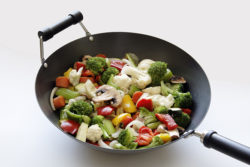
Keeping healthy foods in the kitchen
Having a well-stocked kitchen with long-lasting foods can make meal planning easier and grocery shopping simpler.
Everything expires in different periods of time, but most of these items will stay fresh for at least two weeks. Think about how more perishable foods (e.g. salad greens, milk) and foods that are on sale (e.g. weekly specials) can be used to supplement longer-lasting items. See below for ideas of how to assemble these ingredients into amazing, healthy meals! But don’t be afraid to keep things simple – a homemade sandwich and a veggie side is a much healthier option compared to most orders at a fast food restaurant.
Vegetables
In the cupboard: No-salt-added canned vegetables
In the fridge: Onions, carrots, cabbage, celery, sturdy greens (kale, collards), bell peppers
In the freezer: Non-starchy vegetables with minimal fat/sugar/salt added (plain spinach, broccoli)
Fruits
In the cupboard: Canned fruits in 100% juice, light syrup or extra-light syrup
In the fridge: Apples, citrus fruits (clementines, oranges), pears, plums, kiwi fruit
In the freezer: Frozen fruit chunks or berries without added sugar (peaches, strawberries)
Protein
In the cupboard: Canned/dried beans, canned tuna in water, canned salmon, peanut/nut butter*, nuts*
*Remember to watch portion sizes of nuts
In the fridge: Eggs, reduced-fat or part-skim cheese
In the freezer: Fish fillets, shrimp, skinless poultry portions, lean beef*, lean ground turkey*
*At least 93% lean
Grains
In the cupboard: Whole-wheat pasta, brown rice, whole-wheat bread, oatmeal, whole grain low-sugar cereal, whole wheat flour
In the fridge: Whole-grain tortillas
In the freezer: Extra whole-grain bread or cooked whole grains can be frozen for up to six months in airtight packaging
Dairy
In the fridge: Plain low-fat or non-fat yogurts, light flavored yogurts, plain low-fat or non-fat cottage cheese
Healthy fats
In the cupboard: Canola oil, olive oil
Planning Healthy Meals: 4 Easy Ideas!
1. Mix it up with stir-fry
When you make a colorful stir-fry at home, you can use your favorite vegetables and seasonings! For a better stir-fry:
- Cut all your ingredients before you preheat your pan.
- Once the pan is heated, first add in firm vegetables that need longer cooking, like onions and carrots. Larger chunks, like whole mushrooms or pieces of protein, may also need longer cooking.
- Next, add in semi-firm vegetables that need a moderate amount of cooking, like sliced squash or julienned bell peppers.
- At the end, add in vegetables that need very little cooking, like snow peas and sliced green onions.
Frozen stir-fry mixes are super convenient and can keep prep and clean-up time nice and short!
2. Big flavor bowls
You can make a healthy, flavorful bowl just the way you like it!
Here are some different ideas to inspire your own creation:
- Tomatoes
- Bell peppers
- Cilantro
- Mango or pineapple
- Lean protein (e.g. chicken, shrimp)
- Black, pinto or fat-free refried beans
- Brown rice
- Reduced-fat/part-skim cheese
- Plain low-fat/0% Greek yogurt
______________________
- Bok choy or napa cabbage
- Snow peas
- Carrots
- Bell peppers
- Mushrooms
- Broccoli
- Ginger
- Scallions
- Lean protein (e.g. chicken, shrimp)
- Brown rice or whole-grain noodles
- Low-sodium soy sauce
______________________
- Cucumbers
- Tomatoes
- Celery
- Steamed green beans
- Cooked chicken or chickpeas
- Cooked quinoa
- Low-fat vinaigrette
3. Awesome omelets
Omelets are a great way to use small bits of vegetables and lean protein that you have on hand. You can bake an omelet in the oven and cut it into wedges or make it on the stovetop. Some delicious healthy tips:
- Use half the yolks (or 100% egg whites) to cut calories and still get plenty of protein.
- If adding cheese, use a small amount of lower-fat cheese.
- Use a non-stick skillet and spray it with non-stick spray for easy removal. If you plan to bake the omelet, make sure your pan (including the handle) is oven-safe.
4. Superstar salads
Salad can be a big bowl of greens…or not! Main-dish salads can feature lots of nutrient-rich foods from different food groups. With so many flavorful ingredients, you can go easy on heavy dressings! Think about these less common options the next time you make a salad.
Vegetables:
- Summer squash
- Thinly-sliced cabbage or kale
- Steamed asparagus or green beans
- Mushrooms
- Sugar snap peas
- Radishes
Fruit:
- Berries
- Apples
- Oranges
- Pineapple
- Peaches
- Pears
- Mangoes
Protein:
- Beans
- Cooked turkey or chicken
- Cooked lean beef
- Low-fat cottage cheese
Grains:
- Brown rice
- Barley
- Quinoa

